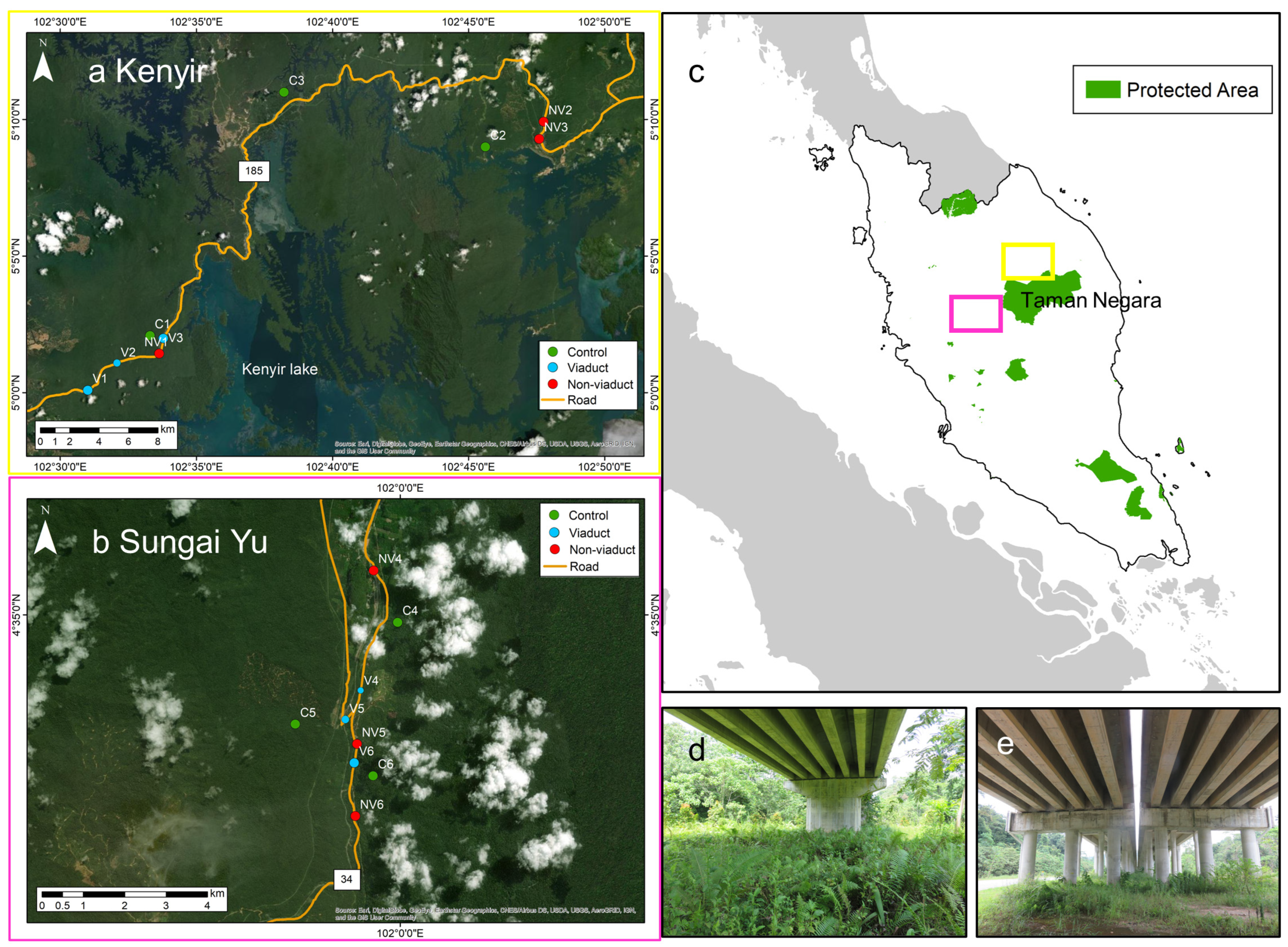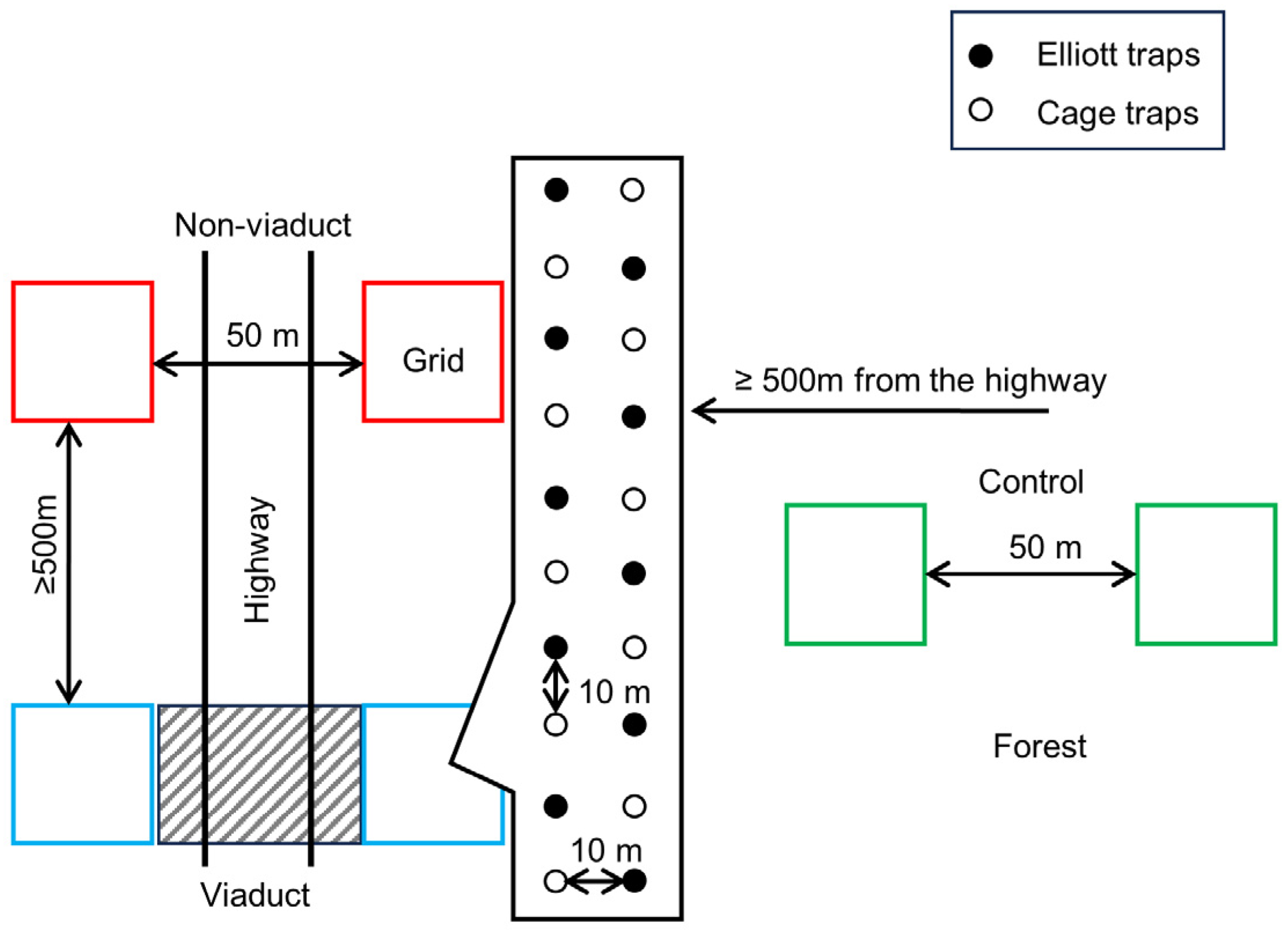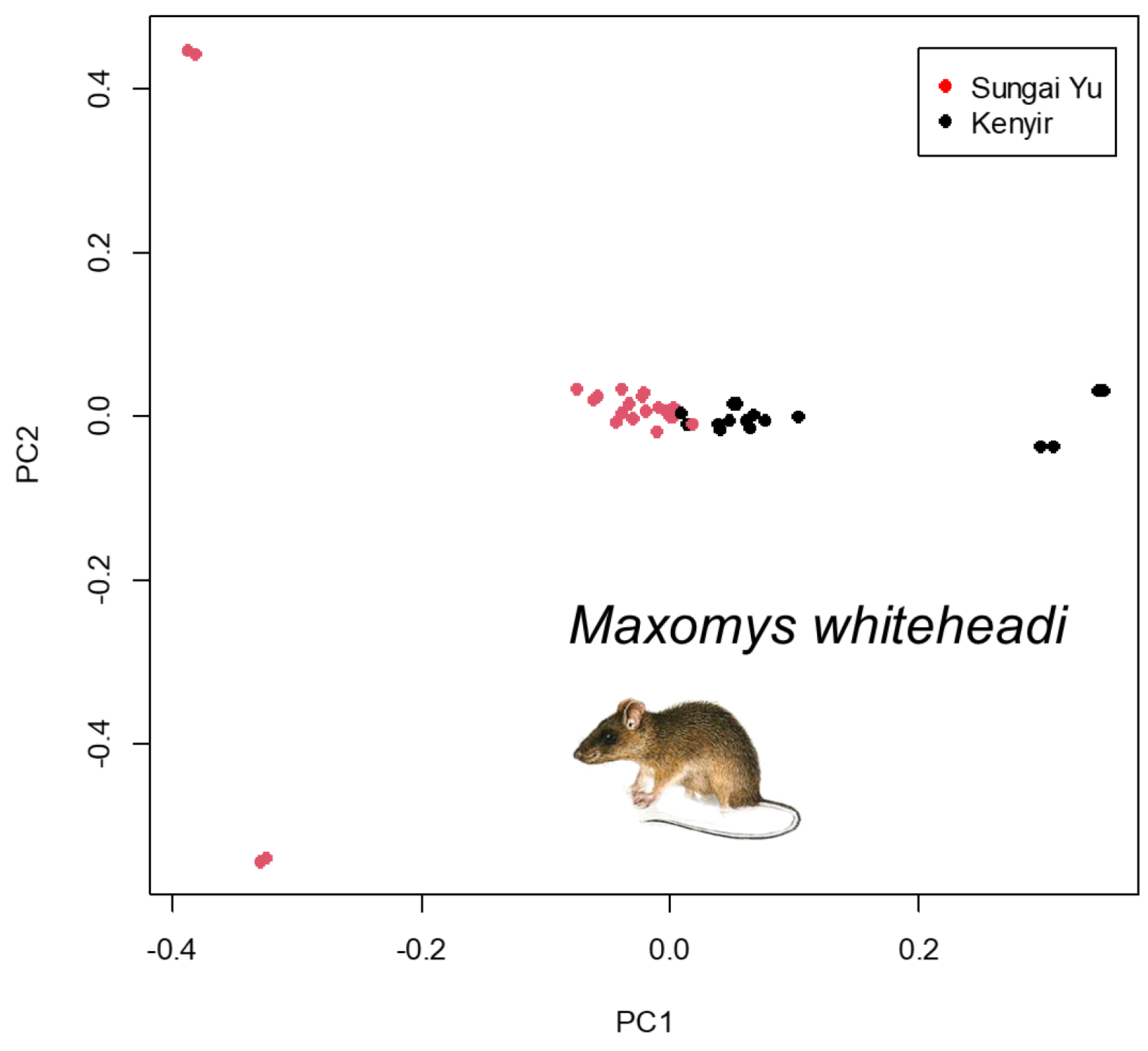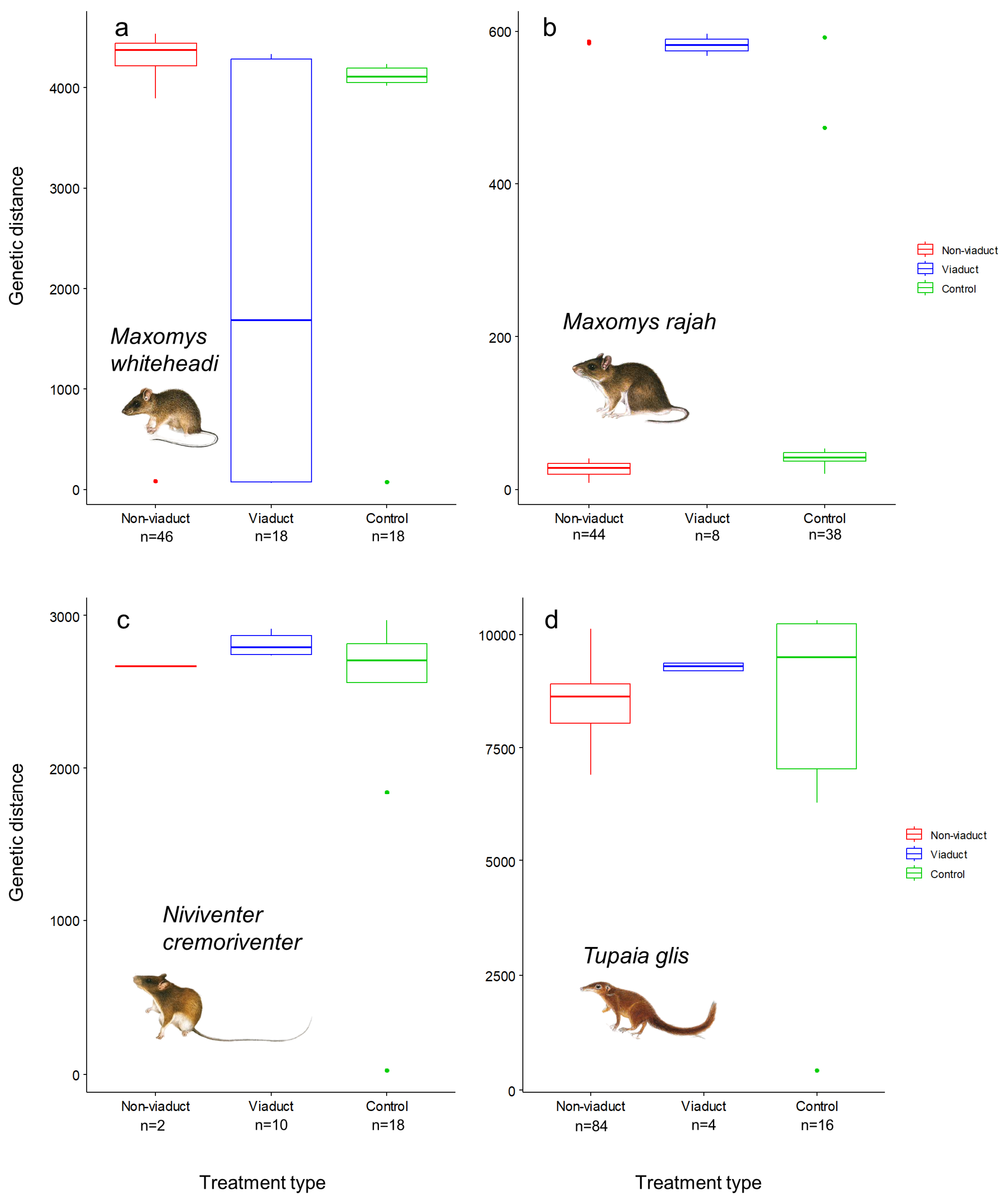Small-Mammal Genomics Highlights Viaducts as Potential Dispersal Conduits for Fragmented Populations
Abstract
Simple Summary
Abstract
1. Introduction
2. Materials and Methods
2.1. Study Sites
2.2. Small Mammal Trapping
2.3. DNA Extraction and ddRAD-Seq Library Preparation
2.4. Statistical Analyses
3. Results
4. Discussion
5. Conclusions
Supplementary Materials
Author Contributions
Funding
Institutional Review Board Statement
Informed Consent Statement
Data Availability Statement
Acknowledgments
Conflicts of Interest
References
- Fahrig, L.; Rytwinski, T. Effects of roads on animal abundance: An empirical review and synthesis. Ecol. Soc. 2009, 14, 1. [Google Scholar] [CrossRef]
- Debinski, D.M.; Holt, R.D. A survey and overview of habitat fragmentation experiments. Conserv. Biol. 2000, 14, 342–355. [Google Scholar] [CrossRef]
- Laurance, W.F. Contemporary drivers of habitat fragmentation. In Global Forest Fragmentation; CABI: Wallingford, UK, 2014; pp. 20–27. [Google Scholar]
- Robert McDonald, W.; Cassady St. Clair, C. The effects of artificial and natural barriers on the movement of small mammals in Banff National Park, Canada. Oikos 2004, 105, 397–407. [Google Scholar] [CrossRef]
- Cros, E.; Ng, E.Y.; Oh, R.R.; Tang, Q.; Benedick, S.; Edwards, D.P.; Tomassi, S.; Irestedt, M.; Ericson, P.G.; Rheindt, F.E. Fine-scale barriers to connectivity across a fragmented South-East Asian landscape in six songbird species. Evol. Appl. 2020, 13, 1026–1036. [Google Scholar] [CrossRef] [PubMed]
- Rivera-Ortíz, F.; Aguilar, R.; Arizmendi, M.; Quesada, M.; Oyama, K. Habitat fragmentation and genetic variability of tetrapod populations. Anim. Conserv. 2015, 18, 249–258. [Google Scholar] [CrossRef]
- Chattopadhyay, B.; Garg, K.M.; Mendenhall, I.H.; Rheindt, F.E. Historic DNA reveals Anthropocene threat to a tropical urban fruit bat. Curr. Biol. 2019, 29, R1299–R1300. [Google Scholar] [CrossRef] [PubMed]
- Ewers, R.M.; Didham, R.K. Confounding factors in the detection of species responses to habitat fragmentation. Biol. Rev. 2006, 81, 117–142. [Google Scholar] [CrossRef]
- Christie, M.R.; Knowles, L.L. Habitat corridors facilitate genetic resilience irrespective of species dispersal abilities or population sizes. Evol. Appl. 2015, 8, 454–463. [Google Scholar] [CrossRef] [PubMed]
- Haddad, N.M.; Bowne, D.R.; Cunningham, A.; Danielson, B.J.; Levey, D.J.; Sargent, S.; Spira, T. Corridor use by diverse taxa. Ecology 2003, 84, 609–615. [Google Scholar] [CrossRef]
- Noss, R.F. Corridors in real landscapes: A reply to Simberloff and Cox. Conserv. Biol. 1987, 1, 159–164. [Google Scholar] [CrossRef]
- Bennett, A.F. Habitat corridors and the conservation of small mammals in a fragmented forest environment. Landsc. Ecol. 1990, 4, 109–122. [Google Scholar] [CrossRef]
- Saunders, D.A.; Hobbs, R.J.; Margules, C.R. Biological consequences of ecosystem fragmentation: A review. Conserv. Biol. 1991, 5, 18–32. [Google Scholar] [CrossRef]
- Mabry, K.E.; Barrett, G.W. Effects of corridors on home range sizes and interpatch movements of three small mammal species. Landsc. Ecol. 2002, 17, 629–636. [Google Scholar] [CrossRef]
- Clevenger, A.P.; Chruszcz, B.; Gunson, K. Drainage culverts as habitat linkages and factors affecting passage by mammals. J. Appl. Ecol. 2001, 38, 1340–1349. [Google Scholar] [CrossRef]
- McDonald, W.; St Clair, C.C. Elements that promote highway crossing structure use by small mammals in Banff National Park. J. Appl. Ecol. 2004, 41, 82–93. [Google Scholar] [CrossRef]
- Bellis, M.A.; Griffin, C.R.; Warren, P.; Jackson, S.D. Utilizing a multi-technique, multi–taxa approach to monitoring wildlife passageways in southern vermont. Oecologia Aust. 2013, 17, 111–128. [Google Scholar] [CrossRef]
- Beier, P.; Noss, R.F. Do habitat corridors provide connectivity? Conserv. Biol. 1998, 12, 1241–1252. [Google Scholar] [CrossRef]
- Haddad, N.M. Finding the corridor more traveled. Proc. Natl. Acad. Sci. USA 2008, 105, 19569–19570. [Google Scholar] [CrossRef]
- Gonzalez, A.; Lawton, J.; Gilbert, F.; Blackburn, T.; Evans-Freke, I. Metapopulation dynamics, abundance, and distribution in a microecosystem. Science 1998, 281, 2045–2047. [Google Scholar] [CrossRef]
- Dunning, J.B.; Borgella, R.; Clements, K.; Meffe, G.K. Patch isolation, corridor effects, and colonization by a resident sparrow in a managed pine woodland. Conserv. Biol. 1995, 9, 542–550. [Google Scholar] [CrossRef]
- Fahrig, L.; Merriam, G. Habitat patch connectivity and population survival. Ecology 1985, 66, 1762–1768. [Google Scholar] [CrossRef]
- Haddad, N.M.; Baum, K.A. An experimental test of corridor effects on butterfly densities. Ecol. Appl. 1999, 9, 623–633. [Google Scholar] [CrossRef]
- Rosenberg, D.K.; Noon, B.R.; Meslow, E.C. Biological corridors: Form, function, and efficacy. BioScience 1997, 47, 677–687. [Google Scholar] [CrossRef]
- Haddad, N.M. Corridor and distance effects on interpatch movements: A landscape experiment with butterflies. Ecol. Appl. 1999, 9, 612–622. [Google Scholar] [CrossRef]
- Tewksbury, J.J.; Levey, D.J.; Haddad, N.M.; Sargent, S.; Orrock, J.L.; Weldon, A.; Danielson, B.J.; Brinkerhoff, J.; Damschen, E.I.; Townsend, P. Corridors affect plants, animals, and their interactions in fragmented landscapes. Proc. Natl. Acad. Sci. USA 2002, 99, 12923–12926. [Google Scholar] [CrossRef] [PubMed]
- Haas, C.A. Dispersal and use of corridors by birds in wooded patches on an agricultural landscape. Conserv. Biol. 1995, 9, 845–854. [Google Scholar] [CrossRef]
- Mech, S.G.; Hallett, J.G. Evaluating the effectiveness of corridors: A genetic approach. Conserv. Biol. 2001, 15, 467–474. [Google Scholar] [CrossRef]
- Sutcliffe, O.L.; Thomas, C.D. Open corridors appear to facilitate dispersal by ringlet butterflies (Aphantopus hyperantus) between woodland clearings. Conserv. Biol. 1996, 10, 1359–1365. [Google Scholar] [CrossRef]
- Beier, P. Dispersal of juvenile cougars in fragmented habitat. J. Wildl. Manag. 1995, 59, 228–237. [Google Scholar] [CrossRef]
- Aars, J.; Ims, R.A. The effect of habitat corridors on rates of transfer and interbreeding between vole demes. Ecology 1999, 80, 1648–1655. [Google Scholar] [CrossRef]
- Hale, M.L.; Lurz, P.W.; Shirley, M.D.; Rushton, S.; Fuller, R.M.; Wolff, K. Impact of landscape management on the genetic structure of red squirrel populations. Science 2001, 293, 2246–2248. [Google Scholar] [CrossRef]
- Orrock, J.L. Conservation corridors affect the fixation of novel alleles. Conserv. Genet. 2005, 6, 623–630. [Google Scholar] [CrossRef]
- Orrock, J.L.; Damschen, E.I. Corridors cause differential seed predation. Ecol. Appl. 2005, 15, 793–798. [Google Scholar] [CrossRef]
- Weldon, A.J.; Haddad, N.M. The effects of patch shape on Indigo Buntings: Evidence for an ecological trap. Ecology 2005, 86, 1422–1431. [Google Scholar] [CrossRef]
- Kjeldsen, S.R.; Zenger, K.R.; Leigh, K.; Ellis, W.; Tobey, J.; Phalen, D.; Melzer, A.; FitzGibbon, S.; Raadsma, H.W. Genome-wide SNP loci reveal novel insights into koala (Phascolarctos cinereus) population variability across its range. Conserv. Genet. 2016, 17, 337–353. [Google Scholar] [CrossRef]
- Szulkin, M.; Gagnaire, P.A.; Bierne, N.; Charmantier, A. Population genomic footprints of fine-scale differentiation between habitats in Mediterranean blue tits. Mol. Ecol. 2016, 25, 542–558. [Google Scholar] [CrossRef]
- Angeloni, F.; Wagemaker, N.; Vergeer, P.; Ouborg, J. Genomic toolboxes for conservation biologists. Evol. Appl. 2012, 5, 130–143. [Google Scholar] [CrossRef] [PubMed]
- Sawaya, M.A.; Kalinowski, S.T.; Clevenger, A.P. Genetic connectivity for two bear species at wildlife crossing structures in Banff National Park. Proc. R. Soc. B Biol. Sci. 2014, 281, 20131705. [Google Scholar] [CrossRef]
- Braunisch, V.; Segelbacher, G.; Hirzel, A.H. Modelling functional landscape connectivity from genetic population structure: A new spatially explicit approach. Mol. Ecol. 2010, 19, 3664–3678. [Google Scholar] [CrossRef]
- Burkart, S.; Gugerli, F.; Senn, J.; Kuehn, R.; Bolliger, J. Evaluating the functionality of expert-assessed wildlife corridors with genetic data from roe deer. Basic Appl. Ecol. 2016, 17, 52–60. [Google Scholar] [CrossRef]
- Brunke, J.; Russo, I.-R.M.; Orozco-terWengel, P.; Zimmermann, E.; Bruford, M.W.; Goossens, B.; Radespiel, U. Dispersal and genetic structure in a tropical small mammal, the Bornean tree shrew (Tupaia longipes), in a fragmented landscape along the Kinabatangan River, Sabah, Malaysia. BMC Genet. 2020, 21, 1–13. [Google Scholar] [CrossRef]
- Steele, G.M.; Randolph, S.E. An experimental evaluation of conventional control measures against the sheep tick, Ixodes ricinus (L.)(Acari: Ixodidae). I. A unimodal seasonal activity pattern. Bull. Entomol. Res. 1985, 75, 489–500. [Google Scholar] [CrossRef]
- Hecht, L.; Allcock, M. Potential Effects of Habitat Fragmentation on Wild Animal Welfare. 2020. Available online: https://www.researchgate.net/publication/342292473_Potential_effects_of_habitat_fragmentation_on_wild_animal_welfare (accessed on 13 November 2023).
- Francis, C.M.; Barrett, P. A Guide to the Mammals of Southeast Asia; New Holland Publishers (UK) Ltd.: London, UK, 2008. [Google Scholar]
- Hoffmann, A.; Decher, J.; Rovero, F.; Schaer, J.; Voigt, C.; Wibbelt, G. Field methods and techniques for monitoring mammals. Man. Field Rec. Tech. Protoc. All Taxa Biodivers. Invent. 2010, 8, 482–529. [Google Scholar]
- Ng, E.Y.; Li, S.; Zhang, D.; Garg, K.M.; Song, G.; Martinez, J.; Hung, L.M.; Tu, V.T.; Fuchs, J.; Dong, L. Genome-wide SNPs confirm plumage polymorphism and hybridisation within a Cyornis flycatcher species complex. Zool. Scr. 2023, 52, 1–16. [Google Scholar] [CrossRef]
- Catchen, J.; Hohenlohe, P.A.; Bassham, S.; Amores, A.; Cresko, W.A. Stacks: An analysis tool set for population genomics. Mol. Ecol. 2013, 22, 3124–3140. [Google Scholar] [CrossRef]
- Li, H.; Durbin, R. Fast and accurate short read alignment with Burrows–Wheeler transform. Bioinformatics 2009, 25, 1754–1760. [Google Scholar] [CrossRef]
- Lerner, H.R.; Meyer, M.; James, H.F.; Hofreiter, M.; Fleischer, R.C. Multilocus resolution of phylogeny and timescale in the extant adaptive radiation of Hawaiian honeycreepers. Curr. Biol. 2011, 21, 1838–1844. [Google Scholar] [CrossRef]
- Li, H.; Handsaker, B.; Wysoker, A.; Fennell, T.; Ruan, J.; Homer, N.; Marth, G.; Abecasis, G.; Durbin, R.; Subgroup, G.P.D.P. The sequence alignment/map format and SAMtools. Bioinformatics 2009, 25, 2078–2079. [Google Scholar] [CrossRef]
- Foll, M.; Gaggiotti, O. A genome-scan method to identify selected loci appropriate for both dominant and codominant markers: A Bayesian perspective. Genetics 2008, 180, 977–993. [Google Scholar] [CrossRef] [PubMed]
- Chang, C.C.; Chow, C.C.; Tellier, L.C.; Vattikuti, S.; Purcell, S.M.; Lee, J.J. Second-generation PLINK: Rising to the challenge of larger and richer datasets. Gigascience 2015, 4, s13742-13015-10047-13748. [Google Scholar] [CrossRef] [PubMed]
- Zheng, X. SNPRelate: Parrallel computing toolset for genome-wide association studies. R Package Version 2012, 95, B9. [Google Scholar]
- Danecek, P.; Auton, A.; Abecasis, G.; Albers, C.A.; Banks, E.; DePristo, M.A.; Handsaker, R.E.; Lunter, G.; Marth, G.T.; Sherry, S.T. The variant call format and VCFtools. Bioinformatics 2011, 27, 2156–2158. [Google Scholar] [CrossRef]
- Kamvar, Z.N.; Tabima, J.F.; Grünwald, N.J. Poppr: An R package for genetic analysis of populations with clonal, partially clonal, and/or sexual reproduction. PeerJ 2014, 2, e281. [Google Scholar] [CrossRef]
- Bougeard, S.; Dray, S. Supervised multiblock analysis in R with the ade4 package. J. Stat. Softw. 2018, 86, 1–17. [Google Scholar] [CrossRef]
- Wright, S. Isolation by distance. Genetics 1943, 28, 114. [Google Scholar] [CrossRef] [PubMed]
- Hui, T.C.; Slade, E.M.; Chong, J.L. Roadkills in Northern Peninsular Malaysia. Front. Environ. Sci. 2021, 9, 637462. [Google Scholar] [CrossRef]
- Hedges, L.; Clements, G.; Aziz, S.; Yap, W.; Laurance, S.; Goosem, M.; Laurance, W. Small carnivore records from a threatened habitat linkage in Terengganu, Peninsular Malaysia. Small Carniv. Conserv. 2013, 49, 9–14. [Google Scholar]
- Mariana, A.; Shukor, M.; Muhd, N.H.; Intan, N.B.; Ho, T. Movements and home range of a common species of tree–shrew, Tupaia glis, surrounding houses of otoacariasis cases in Kuantan, Pahang, Malaysia. Asian Pac. J. Trop. Med. 2010, 3, 427–434. [Google Scholar] [CrossRef]
- Mills, L.S.; Allendorf, F.W. The one-migrant-per-generation rule in conservation and management. Conserv. Biol. 1996, 10, 1509–1518. [Google Scholar] [CrossRef]







| Kenyir | Sungai Yu | ||||
|---|---|---|---|---|---|
| Spatial Distance Model | Mantel r | Simulated p-Value | Mantel r | Simulated p-Value | |
| Euclidean | 0.118 | 0.15 | 0.355 | 0.01 | |
| Maxomys rajah | Road | 0.117 | 0.16 | 0.373 | 0.01 |
| Viaduct | 0.117 | 0.14 | 0.506 | 0.01 | |
| Euclidean | 0.245 | 0.01 | 0.082 | 0.02 | |
| Maxomys whiteheadi | Road | 0.237 | 0.01 | 0.124 | 0.19 |
| Viaduct | 0.237 | 0.01 | 0.126 | 0.22 | |
| Euclidean | 0.096 | 0.1 | |||
| Niviventer cremoriventer | Road | 0.112 | 0.12 | ||
| Viaduct | 0.117 | 0.1 | |||
| Euclidean | 0.121 | 0.17 | 0.113 | 0.17 | |
| Tupaia glis | Road | 0.102 | 0.19 | 0.204 | 0.09 |
| Viaduct | 0.101 | 0.23 | 0.207 | 0.05 | |
Disclaimer/Publisher’s Note: The statements, opinions and data contained in all publications are solely those of the individual author(s) and contributor(s) and not of MDPI and/or the editor(s). MDPI and/or the editor(s) disclaim responsibility for any injury to people or property resulting from any ideas, methods, instructions or products referred to in the content. |
© 2024 by the authors. Licensee MDPI, Basel, Switzerland. This article is an open access article distributed under the terms and conditions of the Creative Commons Attribution (CC BY) license (https://creativecommons.org/licenses/by/4.0/).
Share and Cite
Hui, T.C.Y.; Tang, Q.; Ng, E.Y.X.; Chong, J.L.; Slade, E.M.; Rheindt, F.E. Small-Mammal Genomics Highlights Viaducts as Potential Dispersal Conduits for Fragmented Populations. Animals 2024, 14, 426. https://doi.org/10.3390/ani14030426
Hui TCY, Tang Q, Ng EYX, Chong JL, Slade EM, Rheindt FE. Small-Mammal Genomics Highlights Viaducts as Potential Dispersal Conduits for Fragmented Populations. Animals. 2024; 14(3):426. https://doi.org/10.3390/ani14030426
Chicago/Turabian StyleHui, Tabitha C. Y., Qian Tang, Elize Y. X. Ng, Ju Lian Chong, Eleanor M. Slade, and Frank E. Rheindt. 2024. "Small-Mammal Genomics Highlights Viaducts as Potential Dispersal Conduits for Fragmented Populations" Animals 14, no. 3: 426. https://doi.org/10.3390/ani14030426
APA StyleHui, T. C. Y., Tang, Q., Ng, E. Y. X., Chong, J. L., Slade, E. M., & Rheindt, F. E. (2024). Small-Mammal Genomics Highlights Viaducts as Potential Dispersal Conduits for Fragmented Populations. Animals, 14(3), 426. https://doi.org/10.3390/ani14030426






